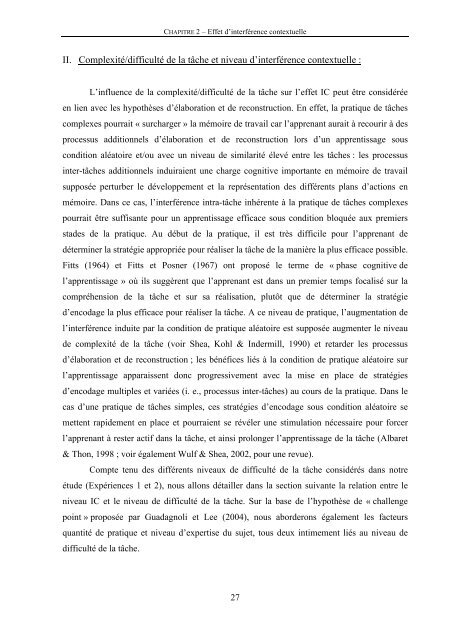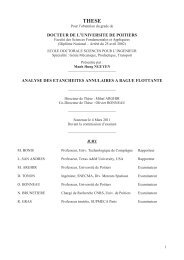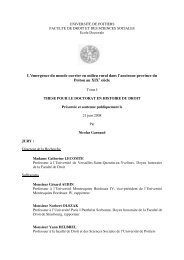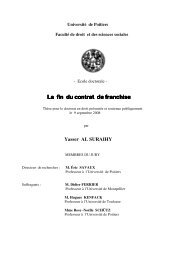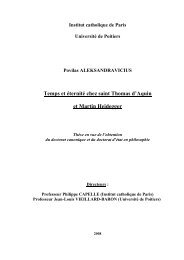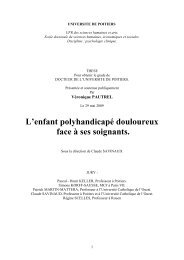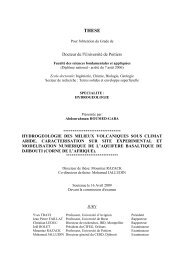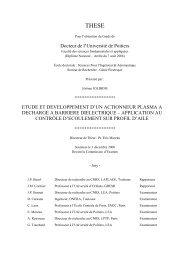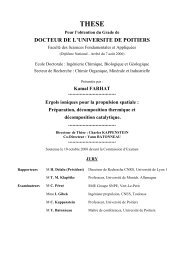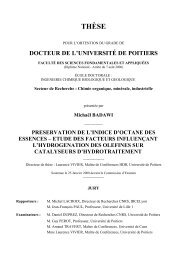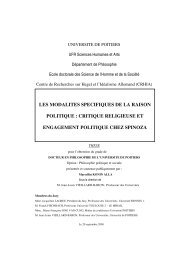Consulter le texte intégral de la thèse - Université de Poitiers
Consulter le texte intégral de la thèse - Université de Poitiers
Consulter le texte intégral de la thèse - Université de Poitiers
You also want an ePaper? Increase the reach of your titles
YUMPU automatically turns print PDFs into web optimized ePapers that Google loves.
CHAPITRE 2 – Effet d’interférence contextuel<strong>le</strong><br />
II. Comp<strong>le</strong>xité/difficulté <strong>de</strong> <strong>la</strong> tâche et niveau d’interférence contextuel<strong>le</strong> :<br />
L’influence <strong>de</strong> <strong>la</strong> comp<strong>le</strong>xité/difficulté <strong>de</strong> <strong>la</strong> tâche sur l’effet IC peut être considérée<br />
en lien avec <strong>le</strong>s hypo<strong>thèse</strong>s d’é<strong>la</strong>boration et <strong>de</strong> reconstruction. En effet, <strong>la</strong> pratique <strong>de</strong> tâches<br />
comp<strong>le</strong>xes pourrait « surcharger » <strong>la</strong> mémoire <strong>de</strong> travail car l’apprenant aurait à recourir à <strong>de</strong>s<br />
processus additionnels d’é<strong>la</strong>boration et <strong>de</strong> reconstruction lors d’un apprentissage sous<br />
condition aléatoire et/ou avec un niveau <strong>de</strong> simi<strong>la</strong>rité é<strong>le</strong>vé entre <strong>le</strong>s tâches : <strong>le</strong>s processus<br />
inter-tâches additionnels induiraient une charge cognitive importante en mémoire <strong>de</strong> travail<br />
supposée perturber <strong>le</strong> développement et <strong>la</strong> représentation <strong>de</strong>s différents p<strong>la</strong>ns d’actions en<br />
mémoire. Dans ce cas, l’interférence intra-tâche inhérente à <strong>la</strong> pratique <strong>de</strong> tâches comp<strong>le</strong>xes<br />
pourrait être suffisante pour un apprentissage efficace sous condition bloquée aux premiers<br />
sta<strong>de</strong>s <strong>de</strong> <strong>la</strong> pratique. Au début <strong>de</strong> <strong>la</strong> pratique, il est très diffici<strong>le</strong> pour l’apprenant <strong>de</strong><br />
déterminer <strong>la</strong> stratégie appropriée pour réaliser <strong>la</strong> tâche <strong>de</strong> <strong>la</strong> manière <strong>la</strong> plus efficace possib<strong>le</strong>.<br />
Fitts (1964) et Fitts et Posner (1967) ont proposé <strong>le</strong> terme <strong>de</strong> « phase cognitive <strong>de</strong><br />
l’apprentissage » où ils suggèrent que l’apprenant est dans un premier temps focalisé sur <strong>la</strong><br />
compréhension <strong>de</strong> <strong>la</strong> tâche et sur sa réalisation, plutôt que <strong>de</strong> déterminer <strong>la</strong> stratégie<br />
d’encodage <strong>la</strong> plus efficace pour réaliser <strong>la</strong> tâche. A ce niveau <strong>de</strong> pratique, l’augmentation <strong>de</strong><br />
l’interférence induite par <strong>la</strong> condition <strong>de</strong> pratique aléatoire est supposée augmenter <strong>le</strong> niveau<br />
<strong>de</strong> comp<strong>le</strong>xité <strong>de</strong> <strong>la</strong> tâche (voir Shea, Kohl & In<strong>de</strong>rmill, 1990) et retar<strong>de</strong>r <strong>le</strong>s processus<br />
d’é<strong>la</strong>boration et <strong>de</strong> reconstruction ; <strong>le</strong>s bénéfices liés à <strong>la</strong> condition <strong>de</strong> pratique aléatoire sur<br />
l’apprentissage apparaissent donc progressivement avec <strong>la</strong> mise en p<strong>la</strong>ce <strong>de</strong> stratégies<br />
d’encodage multip<strong>le</strong>s et variées (i. e., processus inter-tâches) au cours <strong>de</strong> <strong>la</strong> pratique. Dans <strong>le</strong><br />
cas d’une pratique <strong>de</strong> tâches simp<strong>le</strong>s, ces stratégies d’encodage sous condition aléatoire se<br />
mettent rapi<strong>de</strong>ment en p<strong>la</strong>ce et pourraient se révé<strong>le</strong>r une stimu<strong>la</strong>tion nécessaire pour forcer<br />
l’apprenant à rester actif dans <strong>la</strong> tâche, et ainsi prolonger l’apprentissage <strong>de</strong> <strong>la</strong> tâche (Albaret<br />
& Thon, 1998 ; voir éga<strong>le</strong>ment Wulf & Shea, 2002, pour une revue).<br />
Compte tenu <strong>de</strong>s différents niveaux <strong>de</strong> difficulté <strong>de</strong> <strong>la</strong> tâche considérés dans notre<br />
étu<strong>de</strong> (Expériences 1 et 2), nous allons détail<strong>le</strong>r dans <strong>la</strong> section suivante <strong>la</strong> re<strong>la</strong>tion entre <strong>le</strong><br />
niveau IC et <strong>le</strong> niveau <strong>de</strong> difficulté <strong>de</strong> <strong>la</strong> tâche. Sur <strong>la</strong> base <strong>de</strong> l’hypo<strong>thèse</strong> <strong>de</strong> « chal<strong>le</strong>nge<br />
point » proposée par Guadagnoli et Lee (2004), nous abor<strong>de</strong>rons éga<strong>le</strong>ment <strong>le</strong>s facteurs<br />
quantité <strong>de</strong> pratique et niveau d’expertise du sujet, tous <strong>de</strong>ux intimement liés au niveau <strong>de</strong><br />
difficulté <strong>de</strong> <strong>la</strong> tâche.<br />
27


